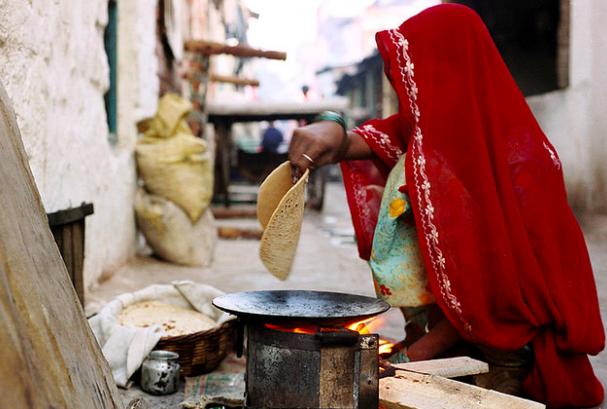COVID19 lockdown: In remote villages, people survive on just dry rotis
A 14-year-old girl, in a remote Indian village Gaon Connection spoke to, offered a perspective on how millions of people in Indian villages are suffering the COVID19 lockdown.

When I reached Khairpura village with my team in the scorching summer heat, a girl, seven or eight years old, caught my attention. She had dry rotis in her hand. On looking closer, I noticed mango pickle between the rotis.
A few steps away was another girl with rotis in her hand. She neither had pickle between the rotis nor was she clothed. Seeing our camera, some people came out of their homes and I noticed they had rotis in their hands too.
It was the third day of our travel in the Bundelkhand region of Uttar Pradesh to cover the impact of the lockdown as part of Gaon Connection’s #CoronaFootprint series. And, in this Khairpura village of Jalandhar gram panchayat of Madavera block in Lalitpur district, dry rotis seemed to be the staple diet of villagers in the lockdown.
Most residents of Khairpura, some 650 kilometres from the national capital New Delhi, and near the border of Madhya Pradesh, belong to Sahariya schedule tribe. Most houses in the village are kachcha and people living in them look older than they are. Their own source of living is bringing wood from the forests and selling it. Some also deal in tendu leaves, a minor forest produce, or make mahua liquor. If not this, their only means of survival is migrating to cities in search of work.
As we walked deeper into the village, we met 14-year-old Roshni who, like other villagers, was eating rotis with pickle. “This is what we eat daily, Sir. Rotis with salt, sometimes with pickle. Not just me, everyone here in the village has been eating the same. We are all poor, isn’t it!” she told Gaon Connection.

On being asked when was the last time she had a wholesome meal of rice, dal (lentil), roti and sabzi (vegetable), she said: “Can’t remember exactly. It’s been around a month since rice, dal, roti, and sabzi were made together at home. No, sabzi wasn’t made that day either.”
Khairpura village has about 170 houses, and almost every house has girls, but it’s only Roshni and her sister who attend school. Other girls either do household work or bring woods from the forest.

Jalandhar gram panchayat in Lalitpur district has four villages including Roshni’s Khairpura village dominated by the Saharia Adivasi community. The village has two Anganwadi centres with 206 children aged between three months to six years registered, 24 pregnant women, and 71 adolescent girls, and 20 working women.
As per the Anganwadi records, all these registered beneficiaries benefit from the various government schemes, but Roshni had a different tale to tell. “Neither any official nor any leader come to our village. ASHA [accredited social health activist] workers visit some specific houses. Many people, officials and others, won’t even talk to us because of our torn, dirty clothes,” said the 14-year-old girl. “ASHA workers stay far away, to avoid touching us because we are dirty. The village next to ours, Sahariyas live there too. They face the same discrimination,” Roshni said.
She claimed the village school was built in a forest area where the kids went, but no one taught. “Children either go to school and play, or they are shut inside a room like animals. They get nothing from the teachers. Not books, not bags, they are not even taught,” she said.

Forty-five-year-old Kesar, a resident of Khairpura village, has three children. Her source of income is bringing wood from the forest and selling it in the village market. Because of the lockdown, she hadn’t sold even a log in the last two months. The government, she informed, was providing free ration — a kilo gram with wheat and rice. However, that was not enough to sustain her family. So she daily prepared a ‘special dish’, a paste, by grinding the gram, and eating bread with it.
“We will get work only when the lockdown opens, else we will die of hunger. The work of bringing wood from the forest is also closed. No money came from the government [to Jan Dhan and LPG accounts] because our accounts were closed,” she told Gaon Connection.
“We raised the issue to the village pradhan [village head] many times, but he does not listen,” she lamented.
Roshni informed in her village, most people had ration cards, but not everyone got free ration. “Sometimes, we are given rotten wheat, rice, and gram, as if we are animals. They think these are poor, illiterate people, what will they understand! But, do we not have the right to eat good food?” she questioned.
To make the Public Distribution System (PDS) across the country more transparent, an Aadhaar-based system is in place. The beneficiary has to give his/her thumb impression to get ration. However, in this new system, the names of thousands of people were dropped from the ration list. And such people suffered during the lockdown.
The Uttar Pradesh government had ordered ration to be given to the poor without ration card, but this was not executed, and many people in Khairpura did not get ration during the lockdown.
She introduced Gaon Connection team to her sister-in-law, Sunita. Sunita had four children, the first two survived. She then had two miscarriages. She claimed the doctors said the miscarriages happened because she was weak.

“Doctors and nurses say you have to eat a lot of green vegetables, but green vegetables are not available. Bhatta (brinjal) and roti or salt and roti are available in the village,” Sunita said.
“During pregnancy, milk, ghee, green vegetables are needed, but where do we get it from! Even vitamin pills are not available here,” the young mother narrated another bitter reality about nutrition and health services in Khairpura village.
Jalandhar village is only a few kilometres from Khairpura, but was completely different. Houses were pucca, tiled and painted. The pradhan‘s house was a two-storey building with a large iron gate outside, and an SUV parked inside.
“Everybody used to get ration, but since Aadhaar-based system came into being, some people started having problems,” said Deepa Singh, pradhan of Jalandhar.
“We told the Kotdar multiple times to give ration to everyone for free, but the Kotdar says he will give ration only to those who give their thumb impression. He gets thumb impressions for two months and distributes ration for a month,” she claimed.
On being questioned about works under MGNREGA, Deepa feigned ignorance while her son, Vaibhav Singh, said: “Under MGNREGA, 30-40 people are given daily work. The rest of them don’t go anywhere to work, just keep accusing they don’t have any work.”
As we left Madavera block of Lalitpur district, Roshni’s words kept echoing in our ears: “Sir, we are very happy today, at least someone came and spoke to us. Usually, people just huff from far away.”
Gaon Connection has promised Roshni she’d be introduced to our citizen journalism project and that she will be trained to become a rural journalist. That way, she will become the voice of her village.

